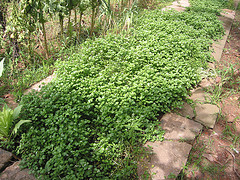Watercress
| Infobox on Watercress | |
|---|---|
| Example of Watercress |  |
| Freshness facts | |
| Optimum carrying temperature | 0°C to 1°C |
| Highest freezing point | -0,3°C |
| Acceptable product temp. at loading into containers | Max. 2°C above carrying temperature |
| Optimum humidity | >95% |
| Ventilation setting for containers | 25 m³/hr |
| Storage life | 2 to 3 weeks |
| Climacteric / non-climacteric | Non-climacteric |
| Ethylene production | Very low |
| Ethylene sensitivity | High |
| Modified / controlled atmosphere | >5% O2; >7 CO2 |
| Potential benefits | Moderate |
| Availability | |
| On demand | |
Watercress
Contents
Harvesting and Handling
Watercress is valued for its attractive dark green leaves, which have a pungent taste and are rich in vitamins. It is used as a leafy salad vegetable. Watercress grows in running water; it was formerly gathered from the wild, but the crop is now commercially produced in specially constructed ‘beds’ which require a constant supply of clear alkaline water.
Harvested watercress is extremely perishable. Unless bunches are placed in water or otherwise protected, the foliage wilts rapidly. In warm conditions the lower leaves quickly fade to yellow, and both stems and leaves may become slimy as a result of bacterial soft rot.
Watercress is very susceptible to dehydration and crushing of leaves. Quality can be maintained only be prompt cooling after harvest.
Cooling and Storage
Optimal holding conditions are a temperature of 0°C and humidity close to saturation. Watercress is best marketed soon after harvest, though if necessary it may be cold-stored for 2 to 3 weeks. Plastic film packaging helps to prevent wilting during marketing.
Naked bunches of watercress are highly perishable even at 0°C and may keep only 3 to 4 days.
In watercress, a 15% weight loss will cause only a trace of wilting, and a 40% weight loss will cause moderate wilting.
Controlled atmosphere considerations
The rate of yellowing can be reduced by storing in atmospheres >7% CO2 with not less than 5% O2.
Watercress is not sensitive to low temperature; store as cold as possible without freezing.
Watercress produces only low amounts of ethylene in response to wounding. However, exposure to ethylene reduces shelf-life due to increased rate of yellowing.
Storage disorders
Bacterial soft rot, De-greening.











